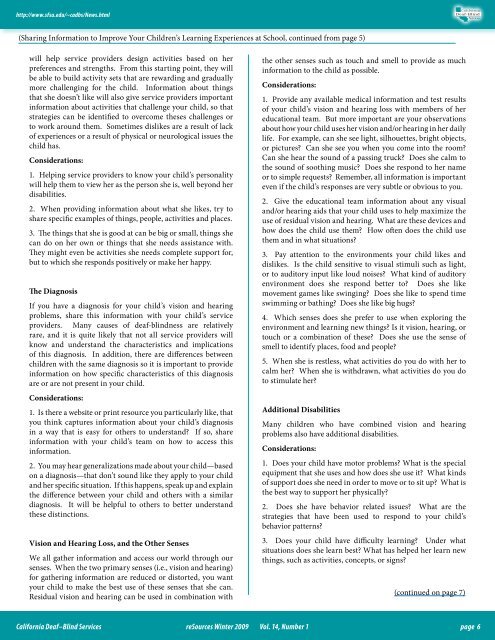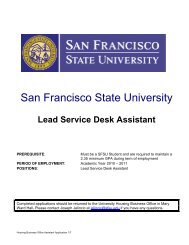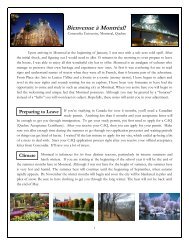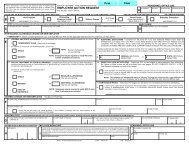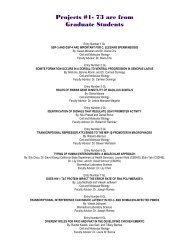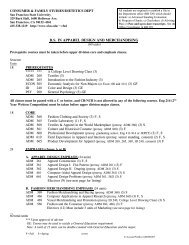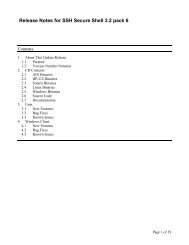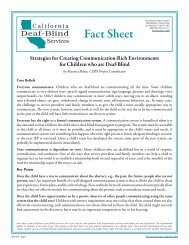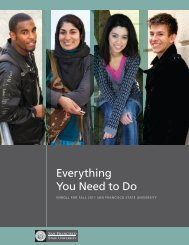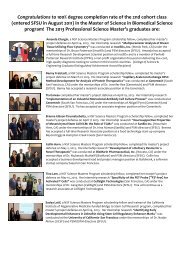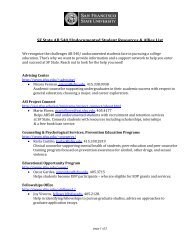reSources Spring 2008 (Vol. 13, No. 2) - San Francisco State ...
reSources Spring 2008 (Vol. 13, No. 2) - San Francisco State ...
reSources Spring 2008 (Vol. 13, No. 2) - San Francisco State ...
Create successful ePaper yourself
Turn your PDF publications into a flip-book with our unique Google optimized e-Paper software.
http://www.sfsu.edu/~cadbs/News.html<br />
California<br />
Deaf-Blind<br />
Services<br />
(Sharing Information to Improve Your Children’s Learning Experiences at School, continued from page 5)<br />
will help service providers design activities based on her<br />
preferences and strengths. From this starting point, they will<br />
be able to build activity sets that are rewarding and gradually<br />
more challenging for the child. Information about things<br />
that she doesn’t like will also give service providers important<br />
information about activities that challenge your child, so that<br />
strategies can be identified to overcome theses challenges or<br />
to work around them. Sometimes dislikes are a result of lack<br />
of experiences or a result of physical or neurological issues the<br />
child has.<br />
Considerations:<br />
1. Helping service providers to know your child’s personality<br />
will help them to view her as the person she is, well beyond her<br />
disabilities.<br />
2. When providing information about what she likes, try to<br />
share specific examples of things, people, activities and places.<br />
3. The things that she is good at can be big or small, things she<br />
can do on her own or things that she needs assistance with.<br />
They might even be activities she needs complete support for,<br />
but to which she responds positively or make her happy.<br />
The Diagnosis<br />
If you have a diagnosis for your child’s vision and hearing<br />
problems, share this information with your child’s service<br />
providers. Many causes of deaf-blindness are relatively<br />
rare, and it is quite likely that not all service providers will<br />
know and understand the characteristics and implications<br />
of this diagnosis. In addition, there are differences between<br />
children with the same diagnosis so it is important to provide<br />
information on how specific characteristics of this diagnosis<br />
are or are not present in your child.<br />
Considerations:<br />
1. Is there a website or print resource you particularly like, that<br />
you think captures information about your child’s diagnosis<br />
in a way that is easy for others to understand? If so, share<br />
information with your child’s team on how to access this<br />
information.<br />
2. You may hear generalizations made about your child—based<br />
on a diagnosis—that don’t sound like they apply to your child<br />
and her specific situation. If this happens, speak up and explain<br />
the difference between your child and others with a similar<br />
diagnosis. It will be helpful to others to better understand<br />
these distinctions.<br />
Vision and Hearing Loss, and the Other Senses<br />
We all gather information and access our world through our<br />
senses. When the two primary senses (i.e., vision and hearing)<br />
for gathering information are reduced or distorted, you want<br />
your child to make the best use of these senses that she can.<br />
Residual vision and hearing can be used in combination with<br />
the other senses such as touch and smell to provide as much<br />
information to the child as possible.<br />
Considerations:<br />
1. Provide any available medical information and test results<br />
of your child’s vision and hearing loss with members of her<br />
educational team. But more important are your observations<br />
about how your child uses her vision and/or hearing in her daily<br />
life. For example, can she see light, silhouettes, bright objects,<br />
or pictures? Can she see you when you come into the room?<br />
Can she hear the sound of a passing truck? Does she calm to<br />
the sound of soothing music? Does she respond to her name<br />
or to simple requests? Remember, all information is important<br />
even if the child’s responses are very subtle or obvious to you.<br />
2. Give the educational team information about any visual<br />
and/or hearing aids that your child uses to help maximize the<br />
use of residual vision and hearing. What are these devices and<br />
how does the child use them? How often does the child use<br />
them and in what situations?<br />
3. Pay attention to the environments your child likes and<br />
dislikes. Is the child sensitive to visual stimuli such as light,<br />
or to auditory input like loud noises? What kind of auditory<br />
environment does she respond better to? Does she like<br />
movement games like swinging? Does she like to spend time<br />
swimming or bathing? Does she like big hugs?<br />
4. Which senses does she prefer to use when exploring the<br />
environment and learning new things? Is it vision, hearing, or<br />
touch or a combination of these? Does she use the sense of<br />
smell to identify places, food and people?<br />
5. When she is restless, what activities do you do with her to<br />
calm her? When she is withdrawn, what activities do you do<br />
to stimulate her?<br />
Additional Disabilities<br />
Many children who have combined vision and hearing<br />
problems also have additional disabilities.<br />
Considerations:<br />
1. Does your child have motor problems? What is the special<br />
equipment that she uses and how does she use it? What kinds<br />
of support does she need in order to move or to sit up? What is<br />
the best way to support her physically?<br />
2. Does she have behavior related issues? What are the<br />
strategies that have been used to respond to your child’s<br />
behavior patterns?<br />
3. Does your child have difficulty learning? Under what<br />
situations does she learn best? What has helped her learn new<br />
things, such as activities, concepts, or signs?<br />
(continued on page 7)<br />
California Deaf–Blind Services <strong>reSources</strong> Winter 2009 <strong>Vol</strong>. 14, Number 1 page 6


